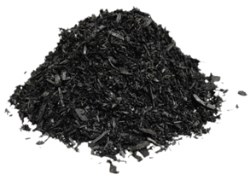Biochar: Potential Growing Medium Component?


Have you ever heard about Biochar? This component has received a lot of attention in recent years because of its nature to lock up significant amounts of carbon, thus reducing carbon emissions into the atmosphere. Not only does it have the capacity to immobilize carbon, but in ancient agricultural practices, charcoal, which is made with a similar process as biochar, was used to enhance soil productivity. Surprisingly, there is little documentation about the use of biochar in modern agriculture.
What is Biochar?
Biochar is a carbon-rich product resulting from the heating of biomass (derived from plants or animals, most commonly from wood) in an oxygen-limited environment. The process involved would be carbon-negative because carbon sources in the biomass would return to the soil without generating CO2 that would escape into the atmosphere.
Biochar can be produced in various ways, ranging from pits in the ground to sophisticated industrial pyrolysis kilns. Pyrolysis is a thermochemical decomposition of organic material at elevated temperatures. The word is from the Greek-derived elements pyro "fire" and lysis "separating”. The process is used to produce charcoal, activated carbon, methanol, and other chemicals from wood; to convert ethylene dichloride into vinyl chloride to make PVC, produce coke from coal and convert biomass into syngas and biochar.

Influence on Soil Chemical Properties
The literature has shown that incorporating biochar into the soil can alter its chemical properties such as CEC, pH and nutrient availability. Biochar application can increase soil carbon immediately, but the carbon in biochar will be unavailable for use in the soil for centuries to millennia.
Biochar can be made from various biomass sources and therefore have different chemical properties. For example, biochar from manure sources has a higher mineral content than biochar from woody sources so they can supply more nutrients to soil, possibly in a slow-release form. Some biochars, particularly those made from paper mill residues and manures processed at high temperatures, have a liming effect and would benefit soils with low pH.
Influence on Soil Microbes and Plants
Biochar application has also been demonstrated to modify the biological activity in the soil by providing a habitat for microorganisms within its highly porous structure or by altering substrate availability and enzyme activities on or around biochar particles. In a few studies, biochar application has been shown to possibly suppress some soil-borne diseases. In a limited number of greenhouse experiments, incorporation of biochar into growing medium has been found to enhance crop yield, increase populations of plant growth-promoting microbes and promote disease suppression.
Inoculating a peat medium with biochar with Rhizobia and mycorrhizal fungi may serve as a potential microbe activator. The research is quite limited but has indicated that these beneficial microbes are more efficient with biochar. More research is required to define the interactions between microorganisms and biochar in various environments. Although more research needs to be conducted, these experiments show promising applications for crops with long production cycles such as greenhouse-grown tomatoes or woody ornamentals.
Future Research Needed
Presently many countries are launching different initiatives for industrial production and distribution of biochar. This should lead to the development of new products for the agricultural and horticultural industry. However, the following points need to be further researched and clarified before biochar will be accepted by the horticulture industry:
- Biochar needs to be processed so it can be dosed into a growing medium using existing equipment, for example, pelletizing would facilitate usage;
- Market the advantages and benefits of different agricultural by-products or biomasses used to make biochar, so that it is not perceived as undesirable waste applied only to soils;
- Determine if fertilizer application rates can be reduced using biochar and what these rates are for different crops and their growing systems;
- Define the stimulation effect biochar may have with beneficial microbes used for plant growth improvement or protection against diseases;
- Determine if fertilizer runoff can be reduced with biochar’s sponge-like, physical properties and investigate the value this brings to nursery, greenhouse and field crops;
- The cost and rates of application of biochar need to be defined for the different applications either in field or greenhouse crops.
In conclusion, the potential of biochar for field soil crops or long-term horticulture crops is promising, but at this point, research has mainly investigated carbon mitigation with biochar applied to soil. Forestry and agriculture generate important biomasses which can be used to make biochar, but these sources are also the third largest fuel after coal and oil. If their transformation into biochar is proven viable on a large scale and beneficial for soil applications and the horticultural industry, biochar could become a significant alternative in reducing CO2 emissions.
Reference
- Cox, J., A. Downie, A. Jenkins, M. Hickey, R. Lines-Kelly, A. McClintock, J. Powell, B. Pal Singh, L. Van Zwieten. 2012. "Biochar in Horticulture: Prospects for the Use of Biochar in Australian Horticulture." Published by NSW Trade and Investment